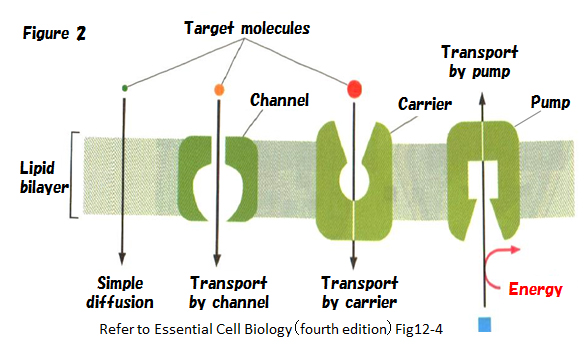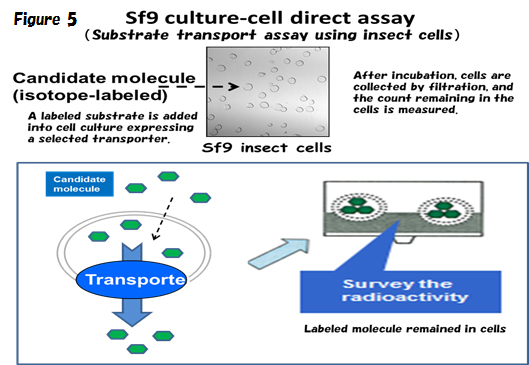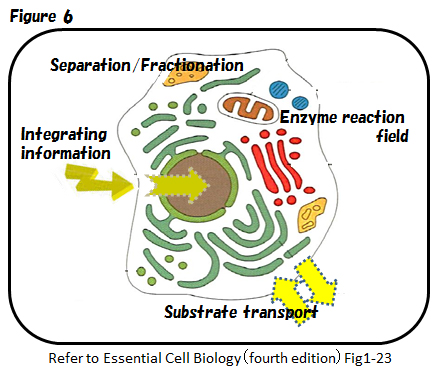Senior Research Scientist
Ph. D.,
profile
- The University of Tokyo, School of Science, BS
- The University of Tokyo, Graduate School of Science, PhD
- National Institute for Basic Biology, Fixed-term Appointed Lecturer
- University of Chicago, Division of Biological Science Research Associate
- RIKEN Genomic Sciences Center, Research Scientist
- Yokohama City University, Visiting Research Scientist
- RIKEN Plant Science Center, Research Scientist
- RIKEN Plant Science Center, Senior Research Scientist
- The University of Tokyo, Visiting Research Scientist
- RIKEN Center for Sustainable Resource Science, Senior Research Scientist
- Aoyama Gakuin University, Visiting Professor
Research
Biomolecule transport and inter-tissue networks
To date, the study of cell signaling has mainly focused on factors inside cells (left side of figure 1, intra-cellular signaling). Membrane-mediated networks are also important for transmitting signals over membranes. This in vivo network controls response and growth at an individual level. Membrane transporters are a key factor for substance transport in both animals and plants. I focus on studying gene functions of membrane transporters

Gene function analysis of membrane transporters
Membrane proteins are necessary for biomaterial transport because only limited molecules can permeate lipid bilayers by simple diffusion. Generally, channels and carriers promote passive transport, and pumps promote active transport, as shown in figure 2. In Arabidopsis, for example, there are about 1,000 transporters. Only a few combinations, however, of transporters and target molecules are known.

Physiological regulation by membrane transporters
Figure 3 shows examples of known combinations of membrane transporters and bioactive molecules. The left side depicts a leaf cross section, showing phytohormone (ABA) transport and transporters between vascular tissues and epidermal tissues (guard cells). The right side shows the inside of a mesophyll cell, displaying ascorbic acid (Vitamin C) transport from mitochondria to chloroplasts, which is involved in the xanthophyll cycle in chloroplasts.

Application research improving plant functions using transporters
Water use efficiency in plants is improved by accelerating expression of a membrane transporter of abscisic acid (ABA; a plant stress and hormone). In Figure 4 the upper photo, taken by infrared thermography, shows repressed transpiration. The lower photo shows enhanced drought tolerance after water stress. A common side effect when stress tolerance is enhanced is growth inhibition. No growth inhibition, however, has been seen in this trial. From this result we infer that controlling transporters can be an additional strategy for improving water use efficiency, along with drought tolerance and growth control.

Substrate transport assay of membrane transporters
The schematic picture in Figure 5 shows a method using cultured insect cells to measure transporter activity. A labeled substrate is added into cell culture that expresses a selected transporter. After incubation, cells are collected by filtration, and the count of substrate molecules remaining in the cells is measured. This may be a convenient method for functional assay of membrane transporters in any organism.

Biological membranes are indispensable for life
The first function biological membranes use to maintain every individual cell and all organelles in cells is “Separation/Fractionation”. Another function used by membranes, “Integrating information”, is contacting other cells and environmental factors to start signal transmission by information. An additional biological membrane function responsible for the molecular networks that establish individuals substantially is “Substrate transport”. A further important role of biological membranes is to promote metabolism and reaction by an “enzyme reaction field”, such as in ATP synthesis and photosynthesis. In these contexts, biological membranes are directly involved in many cellular events, and the dynamic and diverse functions are the source of all life activities.

Main publications
- Kuromori, T(corresponding),Sugimoto, E., Shinozaki, K. (2021) Brachypodium BdABCG25 is a homolog of Arabidopsis AtABCG25 involved in the transport of abscisic acid. FEBS Lett, 595, 954–959
- Takahashi,F.,Kuromori, T, Urano, K., Yamaguchi-Shinozaki, K., Shinozaki, K. (2020) Drought stress responses and resistance in plants: From cellular responses to long-distance intercellular communication. Front Plant Sci, 11, 556972
- Kuromori, T(co-corresponding), Seo, M., Shinozaki, K. (2018) ABA transport and plant water stress responses. Trend Plant Sci, 23, 513-522.
- Kuromori, T(corresponding), Sugimoto, E., Ohiraki, H., Yamaguchi-Shinozaki, K. and Shinozaki, K. (2017) Functional relationship of AtABCG21 and AtABCG22 in stomatal regulation. Sci Rep., 7, 12501.
- Kuromori, T, Fujita, M., Urano, K., Tanabata, T., Sugimoto, E. and Shinozaki, K. (2016) Overexpression of AtABCG25 enhances the abscisic acid signal in guard cells and improves plant water use efficiency. Plant Sci., 251, 75-81.
- Miyaji, T#., Kuromori, T#, Takeuchi, Y., Yamaji, N., Yokosho, K., Shimazawa, A., Sugimoto, E., Omote, H., Ma, J. F., Shinozaki, K. and Moriyama, Y. (2015) AtPHT4;4 is a chloroplast-localized ascorbate transporter in Arabidopsis. Nature communications, 6, 5928.(# equally contri.)
- Kuromori, T(corresponding), Sugimoto, E. and Shinozaki, K. (2014) Inter-tissue signal transfer of abscisic acid from vascular cells to guard cells. Plant Physiol, 164, 1587-1592.
- Kuromori, T(corresponding), Shinozaki, K. (2014) ABA transport by ABCG Transporter Proteins. Signaling and Communication in Plants, 22, 39-47.
- Kuromori, T, Mizoi, J., Umezawa, T., Yamaguchi-Shinozaki, K., Shinozaki, K. (2014) Stress Signaling Networks: Drought stress. The Plant Sciences, 2, 383-409.
- Kuromori, T(corresponding), Ito, T., Sugimoto, E. and Shinozaki, K. (2011) Arabidopsis mutant of AtABCG26, an ABC transporter gene, is defective in pollen maturation. J. Plant Physiol., 168, 2001-2005.
- Kuromori, T, Sugimoto, E. and Shinozaki, K. (2011) Arabidopsis mutants of AtABCG22, an ABC transporter gene, increase water transpiration and drought susceptibility. The Plant Journal, 67, 885-894.
- Kuromori, T and Shinozaki, K. (2010) ABA transport factors found in Arabidopsis ABC transporters. Plant Signal Behav, 5, 1124-1126.
- Kuromori, T, Miyaji, T., Yabuuchi, H., Shimizu, H., Sugimoto, E., Kamiya, A., Moriyama, Y. and Shinozaki, K. (2010) ABC transporter AtABCG25 is involved in abscisic acid transport and responses. Proceedings of the National Academy of Sciences of the United States of America, 107, 2361-2366.
- Kuromori, T, Takahashi, S., Kondou, Y., Shinozaki, K. and Matsui, M. (2009) Phenome analysis in plant species using loss-of-function and gain-of-function mutants. Plant Cell Physiol, 50, 1215-1231.
- Kuromori, T, Azumi, Y., Hayakawa, S., Kamiya, A., Imura, Y., Wada, T., Shinozaki, K. (2008) Homologous chromosome pairing is completed in crossover defective atzip4 mutant. Biochem. Biophys. Res. Commun., 370, 98-103.
- Ukitsu, H#., Kuromori, T#., Toyooka, K., Goto, Y., Matsuoka, K., Sakuradani, E., Shimizu, S., Kamiya, A., Imura, Y., Yuguchi, M., Wada, T., Hirayama, T. and Shinozaki, K. (2007) Cytological and biochemical analysis of COF1, an Arabidopsis mutant of an ABC transporter gene. Plant Cell Physiol., 48, 1524-1533.(# equally contri.)
- Kuromori, T, Wada, T., Kamiya, A., Yuguchi, M., Yokouchi, T., Imura, Y., Takabe, H., Sakurai, T., Akiyama, K., Hirayama, T., Okada, K. and Shinozaki, K. (2006) A trial of phenome analysis using 4000 Ds-insertional mutants in gene-coding regions of Arabidopsis. Plant J, 47, 640-651.
- Kuromori, T, Hirayama, T., Kiyosue, Y., Takabe, H., Mizukado, S., Sakurai, T., Akiyama, K., Kamiya, A., Ito, T. and Shinozaki, K. (2004) A collection of 11 800 single-copy Ds transposon insertion lines in Arabidopsis. Plant J, 37, 897-905.
- Kuromori, T(corresponding), Yamamoto M (2001)Identification of cDNA from Arabidopsis thaliana encoding a member of the conserved SUG1 protein family by complementation screening in fission yeast meiotic mutant. Plant Biotechnology, vol. 18, 169-174.
